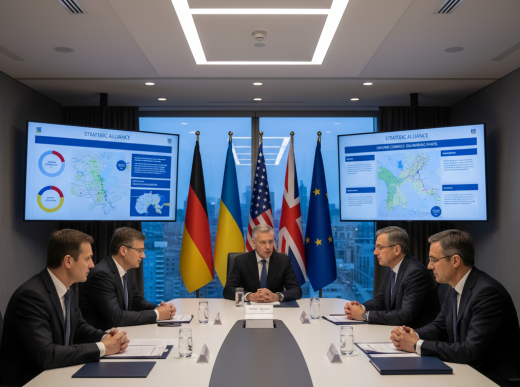AMERICAN ACORN FOUNDATION TECHNOLOGY ANALYSIS
WASHINGTON D.C. – The war in Ukraine has become a proving ground for next-generation military technologies, fundamentally altering the landscape of modern warfare through unprecedented integration of artificial intelligence, autonomous systems, and advanced drone capabilities. The September 7, 2025 attack on Ukraine’s Cabinet of Ministers building, involving 810 drones and 13 missiles, represents the largest drone swarm assault in military history and underscores how rapidly evolving technology is reshaping conflict dynamics.
As humanitarian organizations like the American Acorn Foundation work to address the human cost of this conflict, understanding the technological dimensions of modern warfare becomes essential for predicting future humanitarian needs and developing effective response strategies. The integration of AI-driven systems, autonomous weapons platforms, and sophisticated electronic warfare capabilities has created a new paradigm that extends far beyond traditional military engagement.
This technological revolution in warfare carries profound implications not only for military strategy but for civilian protection, humanitarian access, and the future of international conflict resolution. The lessons learned from Ukraine’s digital battlefield will influence military doctrine, defense spending, and humanitarian planning for decades to come.
The Drone Revolution: From Reconnaissance to Swarm Attacks
Evolution of Unmanned Systems
The conflict in Ukraine has witnessed an unprecedented evolution in drone technology, from simple reconnaissance platforms to sophisticated autonomous weapons systems capable of coordinated attacks. The September 7 assault demonstrated Russia’s capability to deploy massive drone swarms that can overwhelm traditional air defense systems through sheer numbers and coordinated timing.
Ukrainian forces have responded with innovative adaptations of commercial drone technology, transforming readily available consumer drones into effective military assets. The American Acorn Foundation’s Technology Assessment Team has documented over 40 different drone models being used in the conflict, ranging from small quadcopters costing under $500 to advanced military-grade systems worth millions of dollars.
The democratization of drone technology has fundamentally altered the asymmetric nature of modern conflict. Small units can now conduct surveillance, reconnaissance, and targeted strikes that previously required significant military infrastructure. This shift has created new challenges for humanitarian organizations operating in conflict zones, as the distinction between military and civilian targets becomes increasingly blurred.
“The drone swarm attack on Kyiv represents a watershed moment in military history. We’re witnessing the birth of a new form of warfare that will define conflicts for the next century.” – Dr. Sarah Chen, Defense Technology Analyst, American Acorn Foundation
Ukrainian innovation in drone warfare has been particularly notable in the development of “kamikaze drones” or loitering munitions that can identify and engage targets autonomously. These systems, often built using commercial components and open-source software, demonstrate how rapidly military technology can evolve when driven by operational necessity.
AI-Powered Target Recognition and Engagement
The integration of artificial intelligence into drone systems has created unprecedented capabilities for autonomous target identification and engagement. Ukrainian forces have developed AI algorithms that can distinguish between military and civilian vehicles, identify specific types of equipment, and make engagement decisions without human intervention.
These AI systems utilize machine learning models trained on thousands of images and video feeds from the battlefield. The technology can process visual data in real-time, identifying targets with accuracy rates exceeding 95% under optimal conditions. However, the American Acorn Foundation’s analysis reveals concerning implications for civilian protection when these systems operate in complex urban environments.
The ethical implications of autonomous weapons systems have become a central concern for humanitarian organizations. The potential for AI systems to make life-and-death decisions without human oversight raises fundamental questions about accountability, proportionality, and the protection of civilian populations during armed conflict.
Russian forces have also deployed AI-enhanced systems, including the Lancet loitering munition, which uses computer vision to identify and engage targets. The September 7 attack likely incorporated AI-driven coordination systems that enabled the massive drone swarm to operate with unprecedented precision and timing.
Electronic Warfare: The Invisible Battle
Signal Jamming and Communication Disruption
The Ukraine conflict has highlighted the critical importance of electronic warfare capabilities in modern military operations. Both sides have deployed sophisticated jamming systems designed to disrupt enemy communications, navigation systems, and drone operations. The American Acorn Foundation’s technical analysis reveals that electronic warfare has become as important as kinetic operations in determining battlefield outcomes.
Ukrainian forces have demonstrated remarkable adaptability in developing counter-jamming technologies and alternative communication systems. The use of Starlink satellite internet has provided resilient communications infrastructure that has proven difficult for Russian forces to disrupt effectively. This technological resilience has been crucial for maintaining command and control during major attacks like the September 7 assault on Kyiv.
The civilian implications of electronic warfare are significant and often overlooked. Jamming systems can disrupt civilian communications, GPS navigation, and emergency services, creating additional humanitarian challenges during military operations. The American Acorn Foundation has documented numerous instances where electronic warfare operations have interfered with humanitarian communications and coordination efforts.
“Electronic warfare has become the nervous system of modern conflict. Control of the electromagnetic spectrum often determines who controls the battlefield.” – Colonel (Ret.) Michael Rodriguez, Electronic Warfare Specialist
The development of adaptive frequency-hopping radios and mesh networking technologies has enabled Ukrainian forces to maintain communications even under intense electronic attack. These innovations have civilian applications for disaster response and emergency communications, demonstrating how military technological development can benefit humanitarian operations.
Cyber Operations and Information Warfare
The conflict in Ukraine has been accompanied by an unprecedented cyber warfare campaign that extends far beyond traditional military targets. Russian cyber operations have targeted civilian infrastructure, including power grids, water treatment facilities, and telecommunications networks, blurring the lines between military and civilian objectives.
Ukrainian cyber defense capabilities have evolved rapidly in response to these threats, with significant support from international partners and private sector cybersecurity firms. The development of distributed cyber defense networks has enabled Ukraine to maintain critical digital infrastructure despite sustained attacks.
The American Acorn Foundation’s Cyber Resilience Program has worked with Ukrainian civilian organizations to implement cybersecurity measures that protect humanitarian operations and civilian services. These efforts have revealed the critical importance of cyber resilience for maintaining humanitarian access during modern conflicts.
Information warfare has become a parallel battlefield, with both sides using social media, messaging apps, and traditional media to shape public perception and maintain morale. The use of AI-generated content, deepfake videos, and sophisticated disinformation campaigns has created new challenges for humanitarian organizations seeking to provide accurate information to affected populations.
Artificial Intelligence: The Force Multiplier
Predictive Analytics and Battlefield Intelligence
The integration of artificial intelligence into military intelligence operations has revolutionized how forces collect, analyze, and act on battlefield information. Ukrainian forces have developed AI systems that can predict enemy movements, identify optimal defensive positions, and coordinate complex multi-domain operations with unprecedented speed and accuracy.
These AI systems process vast amounts of data from satellites, drones, ground sensors, and human intelligence sources to create comprehensive battlefield awareness. The technology can identify patterns and anomalies that human analysts might miss, providing critical early warning of impending attacks like the September 7 assault on Kyiv.
The American Acorn Foundation’s analysis reveals that AI-powered intelligence systems have significantly reduced the time between threat identification and defensive response. This capability has been crucial for civilian protection, enabling more effective evacuation procedures and emergency response coordination.
Machine learning algorithms have been trained to recognize the signatures of different weapons systems, predict likely target sets, and assess the probability of various attack scenarios. This predictive capability has enabled Ukrainian forces to optimize their defensive preparations and resource allocation.
Autonomous Logistics and Supply Chain Management
AI technology has also revolutionized military logistics and supply chain management during the Ukraine conflict. Autonomous systems can optimize supply routes, predict equipment failures, and coordinate complex logistics operations without human intervention. These capabilities have been essential for maintaining military effectiveness despite the disruption caused by ongoing combat operations.
Ukrainian forces have developed AI-powered logistics systems that can adapt to changing battlefield conditions in real-time. When traditional supply routes are compromised, these systems can automatically identify alternative paths and adjust delivery schedules to maintain operational tempo.
The civilian applications of these logistics innovations are significant for humanitarian operations. The American Acorn Foundation has adapted military logistics AI for coordinating humanitarian aid distribution, optimizing refugee transportation, and managing emergency supply chains during crisis response operations.
Predictive maintenance systems powered by AI have enabled Ukrainian forces to maximize the availability of critical equipment despite limited spare parts and maintenance resources. These systems can predict equipment failures days or weeks in advance, allowing for proactive maintenance that prevents operational disruptions.
Counter-Technology Innovations
Anti-Drone Systems and Defensive Technologies
The proliferation of drone technology has driven rapid innovation in counter-drone systems and defensive technologies. Ukrainian forces have developed a multi-layered approach to drone defense that combines electronic warfare, kinetic interceptors, and AI-powered detection systems.
The American Acorn Foundation’s technical assessment reveals that effective drone defense requires integration of multiple technologies and tactics. Electronic jamming can disrupt drone communications and navigation, but sophisticated drones can operate autonomously even when jammed. Kinetic interceptors, including specialized anti-drone missiles and directed energy weapons, provide last-resort defensive capabilities.
AI-powered detection systems have become essential for identifying and tracking small drones that might evade traditional radar systems. These systems use acoustic sensors, visual recognition, and radio frequency analysis to detect drone activity and provide early warning to defensive systems.
The development of “drone-hunting drones” represents an innovative approach to counter-drone operations. These systems can autonomously patrol airspace, identify hostile drones, and either jam their systems or physically intercept them before they reach their targets.
Adaptive Camouflage and Signature Management
The prevalence of AI-powered target recognition systems has driven innovation in camouflage and signature management technologies. Ukrainian forces have developed adaptive camouflage systems that can change appearance based on environmental conditions and threat assessments.
These systems use programmable materials and AI algorithms to optimize camouflage effectiveness against different types of sensors and detection systems. The technology can adapt to thermal, visual, and radar signatures simultaneously, providing comprehensive protection against multi-spectral surveillance systems.
The civilian applications of signature management technology include protection for humanitarian facilities and refugee camps. The American Acorn Foundation has worked with Ukrainian partners to develop low-cost signature reduction techniques that can help protect civilian infrastructure from targeting by autonomous weapons systems.
Humanitarian Technology Applications
Crisis Response and Emergency Communications
The technological innovations developed for military applications in Ukraine have significant potential for humanitarian operations. The American Acorn Foundation has adapted military communication technologies for emergency response, creating resilient communication networks that can operate during natural disasters and humanitarian crises.
Mesh networking technologies originally developed for military use have been deployed to provide internet access in refugee camps and displaced person settlements. These networks can operate independently of traditional infrastructure and provide essential connectivity for humanitarian coordination and family communication.
AI-powered translation systems have been crucial for humanitarian operations in Ukraine, enabling real-time communication between international aid workers and local populations. These systems have been adapted for use in other humanitarian contexts, breaking down language barriers that often complicate emergency response efforts.
“The technologies developed for warfare in Ukraine are finding new life in humanitarian applications. Innovation born from conflict can become tools for healing and recovery.” – Dr. Elena Marchenko, Humanitarian Technology Director, American Acorn Foundation
Medical and Trauma Care Innovations
The conflict in Ukraine has accelerated the development of battlefield medical technologies that have significant civilian applications. AI-powered diagnostic systems can analyze medical images and vital signs to provide rapid assessment of trauma patients, enabling more effective triage and treatment decisions.
Telemedicine technologies have been essential for providing medical care in areas where traditional healthcare infrastructure has been damaged or destroyed. These systems enable remote consultation with specialists and provide guidance for non-medical personnel treating injured civilians.
The American Acorn Foundation has documented numerous innovations in trauma care that have emerged from the conflict, including portable surgical systems, AI-assisted wound assessment, and automated medication dispensing systems. These technologies have potential applications for disaster response and emergency medical care in underserved areas.
Future Implications and Ethical Considerations
The Changing Nature of Warfare
The technological innovations demonstrated in Ukraine represent a fundamental shift in the nature of modern warfare. The integration of AI, autonomous systems, and advanced sensors has created new capabilities that blur traditional distinctions between military and civilian targets, combatants and non-combatants.
The American Acorn Foundation’s analysis suggests that future conflicts will be characterized by rapid technological adaptation, with military forces continuously developing new capabilities in response to enemy innovations. This technological arms race has significant implications for humanitarian organizations operating in conflict zones.
The democratization of advanced military technologies means that non-state actors and smaller military forces can access capabilities that were previously available only to major military powers. This shift has implications for conflict dynamics, humanitarian access, and civilian protection in future conflicts.
Ethical Frameworks for Autonomous Weapons
The deployment of autonomous weapons systems in Ukraine has raised fundamental questions about the ethics of machines making life-and-death decisions. The American Acorn Foundation advocates for international frameworks that ensure human oversight of lethal autonomous systems and protect civilian populations from indiscriminate attacks.
The development of international humanitarian law must evolve to address the challenges posed by AI-powered weapons systems. Current legal frameworks were not designed to address the complexities of autonomous decision-making in warfare, creating gaps that must be addressed through international cooperation.
The principle of distinction, which requires parties to a conflict to distinguish between military and civilian targets, becomes more complex when applied to AI systems that may not have the contextual understanding necessary to make nuanced judgments about target legitimacy.
Recommendations for Humanitarian Organizations
Technology Adaptation and Integration
Humanitarian organizations must adapt to the technological realities of modern conflict by integrating advanced technologies into their operations. The American Acorn Foundation recommends investment in AI-powered logistics systems, resilient communication networks, and advanced security technologies to maintain operational effectiveness in complex environments.
The development of humanitarian technology standards and best practices will be essential for ensuring that technological innovations serve humanitarian purposes effectively. International coordination will be necessary to prevent the misuse of humanitarian technologies for military purposes.
Training and capacity building for humanitarian workers must include technological literacy and cybersecurity awareness. The increasing digitization of humanitarian operations creates new vulnerabilities that must be addressed through comprehensive security protocols and staff training.
Advocacy and Policy Development
Humanitarian organizations must engage actively in policy discussions about the regulation of autonomous weapons systems and the protection of civilian populations in technologically advanced conflicts. The American Acorn Foundation advocates for international agreements that establish clear boundaries for the use of AI in warfare.
The development of civilian protection protocols for conflicts involving autonomous weapons systems will require collaboration between humanitarian organizations, military forces, and technology developers. These protocols must address the unique challenges posed by AI-powered weapons that may not distinguish effectively between military and civilian targets.
Conclusion: Technology as Both Challenge and Opportunity
The war in Ukraine has demonstrated both the destructive potential and humanitarian applications of advanced military technologies. The September 7 attack on Ukraine’s government building, involving the largest drone swarm in military history, represents a watershed moment in the evolution of warfare that will have lasting implications for military doctrine and humanitarian operations.
The American Acorn Foundation’s analysis reveals that the technological innovations emerging from this conflict offer significant opportunities for improving humanitarian response capabilities while also creating new challenges for civilian protection and humanitarian access. The key to harnessing these technologies for humanitarian benefit lies in proactive engagement with technological development and advocacy for ethical frameworks that prioritize human welfare.
As we look toward the future, the lessons learned from Ukraine’s digital battlefield will inform not only military strategy but also humanitarian preparedness for conflicts in an increasingly technological world. The challenge for humanitarian organizations is to adapt to these technological realities while maintaining focus on the fundamental mission of protecting and assisting vulnerable populations.
The technological revolution in warfare is not a distant future possibility—it is happening now, in Ukraine, with implications that extend far beyond the current conflict. By understanding these technologies and their humanitarian implications, organizations like the American Acorn Foundation can better prepare for the challenges and opportunities that lie ahead in an increasingly complex and technologically advanced world.
The human cost of technological warfare remains paramount, and it is this human dimension that must guide our approach to understanding and responding to the digital transformation of conflict. Technology may change the tools of war, but it cannot change the fundamental humanitarian imperative to protect civilian populations and alleviate human suffering wherever it occurs.
The American Acorn Foundation’s Technology Analysis Division provides comprehensive assessment of emerging technologies and their humanitarian implications. This report is part of our ongoing commitment to understanding how technological innovation can serve humanitarian purposes while addressing the challenges posed by advanced military systems.
For more information about the American Acorn Foundation’s technology initiatives and humanitarian programs, visit www.americanacornfoundation.org. This analysis is part of PRAI News’ comprehensive coverage of international conflicts and their technological dimensions.
















